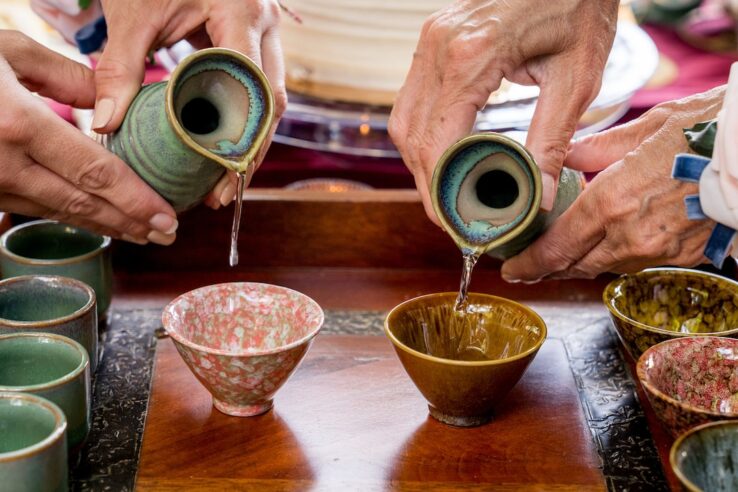Sake and Socializing: Hosting the Perfect Sake Tasting Party
In the United States, throwing a party is a great way to meet and catch up with friends. Research shows that Americans spend around $38 billion on party supplies annually.
If you’re out of ideas for your next party theme, have you considered becoming a sake professional for the day? A sake-tasting party is a perfect opportunity to sample different types of sake while and learn about new cultures.
However, planning this type of party might seem overwhelming if you need help knowing where to begin. You might even be wondering how much you need to know about sake.
Luckily this guide is here to help you understand more about hosting a sake party, so keep reading to learn. You should be a more confident host after reading this blog.
What Is Sake?
Sake is an alcoholic beverage that’s often also called Japanese rice wine. It originated in Japan but is now made in several countries worldwide. It typically has an alcohol content of 15-22%.
It’s made from rice, similar to how beer is made. The starch is converted into sugars and fermented into alcohol to create the sake. Of course, the process is much more complex if you want to read further about it.
You can enjoy your sake cold, but where it’s traditionally served, it’s often done with a special ceremony where it’s gently warmed. The temperature at which you serve sake varies depending on the poured type. It matters because it can completely change the tasting experience.
How to Host a Sake Tasting Gathering
Now that you’re familiar with sake, let’s move on to the fun part: how to host a sake tasting. You might wonder how many options you should start with, what glasses you need, and whether you should pair them with food. We’ll answer all those, but if you’re serious about learning more, you can take some courses such as:
- Sake Sommelier
- Sochu Advisor
- JSA Sake Diploma
Types of Sake
You can purchase and serve several types of sake, although you may be limited to what’s available in your area. Try to buy three to five different bottles. The five main types of sake are:
- Junmai
- Ginjo
- Daiginjo
- Honjozo
- Namazake
If you can’t get hold of all these types, buy what you have access to, but remember to store them in a cool, dark place until your debut as a sake professional.
Serving The Sake
When serving your sake, an easy order is in order of price. Start with the lowest-costing sake and work up to the most expensive bottle. Typically, this means you start with the heavier-tasting sake to lighter-tasting and more sophisticated.
You can also purchase small wooden boxes called “Masu.” Place a cup inside the box and pour the sake until it spills over.
To drink it, remove the cup from the Masu, wipe the bottom, and drink. Once finished, pour the rest of the sake from the box into your glass or drink it straight from the Masu.
Food and Glassware
When hosting your sake tasting event, you want to ensure you pair the sake with some food. The food you serve will depend on the type of sake you’re buying, but some common foods can include:
- Sushi
- Grilled chicken skewers
- Rich flavor food
You can use wine glasses or glass tumblers when serving your sake but use small ceramic cups to stick to tradition. These ceramic cups are also called ochokos.
Sake Etiquette
Being a sake professional for the day and throwing a sake tasting gathering doesn’t have to be overwhelming now that you know more about hosting one. Next up is brushing up on your sake etiquette so you don’t make any faux pas as the host.
Receiving the Sake
It’s customary to pick up your glass when being poured sake. Never place it on the table. Instead, you should hold the cup with both hands to receive the sake.
Finally, take a sip immediately after being served. Placing the glass down before taking doing so is seen as impolite.
How to Pour Sake
Never pour your own sake. It’s traditional to serve others instead, which is considered an act of politeness in Japanese culture.
When pouring the sake, you’ll notice the sake bottle has a pinched part of the mouth. You should pour with this pinched piece facing upwards.
When it’s your time to pour for everyone, hold the bottle with both hands and start pouring at a trickle. Let the sake flow and then return to finish at a trickle.
How to Drink Sake
Always finish what’s in your cup before being poured more. Knowing how to drink sake is critical, and you should sip it rather than “knock it back” like a shooter.
Checking the carafe by shaking it or looking inside is also considered impolite. Instead, you should judge how full it is by its weight.
What Never to Do
Never combine the contents of two sake bottles. When you do this, it can negatively affect the temperature and taste of the sake. It’s also considered rude.
When pouring the sake, never fill the sake cup to the brim. This makes it difficult for the receiver to drink and can easily be spilled. Use a Masu if you want to overfill the glass.
Become a Sake Professional and Wow Your Guests
Hosting a sake party is an excellent way to learn more about another culture. Start by buying three to five bottles of sake and serving them from least to most expensive. You can offer the sake of hot or cold but remember to refrain from pouring your own.
If someone is pouring for you, hold your cup in both hands and take a sip before setting it down on the table. Finally, check the carafe by judging its weight rather than shaking it or looking inside.
If you want to earn your sake professional certification, find your course here. We have several you can choose from, available in English and Japanese.


